有时候我们希望直接查看当前系统下的全部 PCI 设备信息,可以使用下面的命令:
wmic path Win32_PnPEntity where "PNPDeviceID like '%VEN%'" get PNPDeviceID, Status, Manufacturer, Service
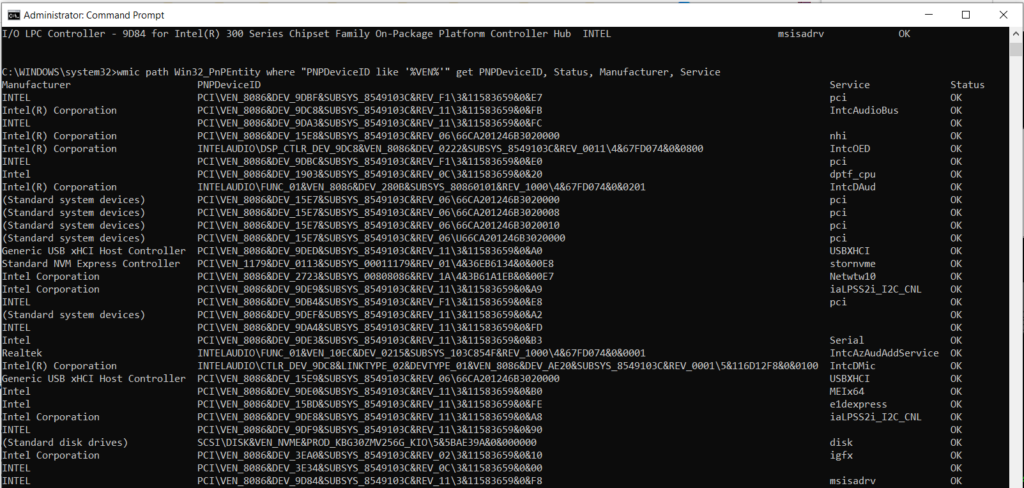
方法来自:http://programming.realworldrobotics.com/editors-ides/command-line-in-windows/wmic-snippets
有时候我们希望直接查看当前系统下的全部 PCI 设备信息,可以使用下面的命令:
wmic path Win32_PnPEntity where "PNPDeviceID like '%VEN%'" get PNPDeviceID, Status, Manufacturer, Service

方法来自:http://programming.realworldrobotics.com/editors-ides/command-line-in-windows/wmic-snippets
Job Title
Firmware/BIOS Quality Engineer
Job Responsibility:
In this position, you will be part of the Firmware Integration and Validation (FIV) Team within SATG responsible for UEFI Firmware/BIOS quality assurance on Intel server platforms. Behavioral traits for this position include: validation infrastructure and test case development, in-depth bug investigation and fix, good communication and problem solving skills, multi-tasking, self-motivation and the ability to collaborate with internal/external stakeholders.
The candidate’s responsibilities will include but not limit to:
Qualifications:
The candidate should possess a Master or a Bachelor degree in computer science, Computer Engineering or a related field, with at least 5 years industrial experience on BIOS development or testing. Additional qualifications include:
有兴趣的朋友可以直接联系:jinghua.xu@intel.com
除了SPD 中给出的参数,在内存初始化时,CPU 还需要有针对性的获得一些参数,而这些参数和生产制造环境温度等等情况有关系(听起来时玄学)。因此,在开机的时候内存控制器会进行一个 Memory Training 的动作。比如,当前内存槽上有2根内存,但是因为线长的原因,同样的信号到达内存的时间不同。在开机的时候,内存控制器就发出一个信号分别给两个内存,内存收到信号后发送一个应答。根据回复的时间不同,内存控制器可以取得一个能够让两个内存都工作正常的时序。当然,这里只是非常粗略的介绍,实际上这个过程非常复杂,耗时也会很久。而Training完成后,BIOS会将取得的参数保存在SPI NOR 上。这也是为什么第一次刷过BIOS之后开机要很久的原因。
一些情况下,我们希望强制进行 Memory Training,通常的方法是进行 Clear CMOS。这次提供了一个 Windows 工具,运行之后重启,SoC 即会进行完整的 Memory Training。
适用范围: ADL-P/M 平台的设备
这一次使用 CH567 制作一个USB键盘,参考的对象是Dostyle 的MK60 机械键盘。

同样的,使用 USBlyzer 抓取描述符信息:
USB Composite Device
| Connection Status | Device connected |
| Current Configuration | 1 |
| Speed | Full (12 Mbit/s) |
| Device Address | 8 |
| Number Of Open Pipes | 2 |
Device Descriptor Gaming KB
| Offset | Field | Size | Value | Description |
| 0 | bLength | 1 | 12h | |
| 1 | bDescriptorType | 1 | 01h | Device |
| 2 | bcdUSB | 2 | 0110h | USB Spec 1.1 |
| 4 | bDeviceClass | 1 | 00h | Class info in Ifc Descriptors |
| 5 | bDeviceSubClass | 1 | 00h | |
| 6 | bDeviceProtocol | 1 | 00h | |
| 7 | bMaxPacketSize0 | 1 | 08h | 8 bytes |
| 8 | idVendor | 2 | 258Ah | |
| 10 | idProduct | 2 | 002Ah | |
| 12 | bcdDevice | 2 | 1201h | 12.01 |
| 14 | iManufacturer | 1 | 01h | “SINO WEALTH” |
| 15 | iProduct | 1 | 02h | “Gaming KB “ |
| 16 | iSerialNumber | 1 | 00h | |
| 17 | bNumConfigurations | 1 | 01h |
Configuration Descriptor 1 Bus Powered, 500 mA
| Offset | Field | Size | Value | Description |
| 0 | bLength | 1 | 09h | |
| 1 | bDescriptorType | 1 | 02h | Configuration |
| 2 | wTotalLength | 2 | 003Bh | |
| 4 | bNumInterfaces | 1 | 02h | |
| 5 | bConfigurationValue | 1 | 01h | |
| 6 | iConfiguration | 1 | 00h | |
| 7 | bmAttributes | 1 | A0h | Bus Powered, Remote Wakeup |
| 4..0: Reserved | …00000 | |||
| 5: Remote Wakeup | ..1….. | Yes | ||
| 6: Self Powered | .0…… | No, Bus Powered | ||
| 7: Reserved (set to one) (bus-powered for 1.0) | 1……. | |||
| 8 | bMaxPower | 1 | FAh | 500 mA |
Interface Descriptor 0/0 HID, 1 Endpoint
| Offset | Field | Size | Value | Description |
| 0 | bLength | 1 | 09h | |
| 1 | bDescriptorType | 1 | 04h | Interface |
| 2 | bInterfaceNumber | 1 | 00h | |
| 3 | bAlternateSetting | 1 | 00h | |
| 4 | bNumEndpoints | 1 | 01h | |
| 5 | bInterfaceClass | 1 | 03h | HID |
| 6 | bInterfaceSubClass | 1 | 01h | Boot Interface |
| 7 | bInterfaceProtocol | 1 | 01h | Keyboard |
| 8 | iInterface | 1 | 00h |
| Offset | Field | Size | Value | Description |
| 0 | bLength | 1 | 09h | |
| 1 | bDescriptorType | 1 | 21h | HID |
| 2 | bcdHID | 2 | 0111h | 1.11 |
| 4 | bCountryCode | 1 | 00h | |
| 5 | bNumDescriptors | 1 | 01h | |
| 6 | bDescriptorType | 1 | 22h | Report |
| 7 | wDescriptorLength | 2 | 0043h | 67 bytes |
Endpoint Descriptor 81 1 In, Interrupt, 1 ms
| Offset | Field | Size | Value | Description |
| 0 | bLength | 1 | 07h | |
| 1 | bDescriptorType | 1 | 05h | Endpoint |
| 2 | bEndpointAddress | 1 | 81h | 1 In |
| 3 | bmAttributes | 1 | 03h | Interrupt |
| 1..0: Transfer Type | ……11 | Interrupt | ||
| 7..2: Reserved | 000000.. | |||
| 4 | wMaxPacketSize | 2 | 0008h | 8 bytes |
| 6 | bInterval | 1 | 01h | 1 ms |
Interface Descriptor 1/0 HID, 1 Endpoint
| Offset | Field | Size | Value | Description |
| 0 | bLength | 1 | 09h | |
| 1 | bDescriptorType | 1 | 04h | Interface |
| 2 | bInterfaceNumber | 1 | 01h | |
| 3 | bAlternateSetting | 1 | 00h | |
| 4 | bNumEndpoints | 1 | 01h | |
| 5 | bInterfaceClass | 1 | 03h | HID |
| 6 | bInterfaceSubClass | 1 | 00h | |
| 7 | bInterfaceProtocol | 1 | 00h | |
| 8 | iInterface | 1 | 00h |
| Offset | Field | Size | Value | Description |
| 0 | bLength | 1 | 09h | |
| 1 | bDescriptorType | 1 | 21h | HID |
| 2 | bcdHID | 2 | 0111h | 1.11 |
| 4 | bCountryCode | 1 | 00h | |
| 5 | bNumDescriptors | 1 | 01h | |
| 6 | bDescriptorType | 1 | 22h | Report |
| 7 | wDescriptorLength | 2 | 00CCh | 204 bytes |
Endpoint Descriptor 82 2 In, Interrupt, 1 ms
| Offset | Field | Size | Value | Description |
| 0 | bLength | 1 | 07h | |
| 1 | bDescriptorType | 1 | 05h | Endpoint |
| 2 | bEndpointAddress | 1 | 82h | 2 In |
| 3 | bmAttributes | 1 | 03h | Interrupt |
| 1..0: Transfer Type | ……11 | Interrupt | ||
| 7..2: Reserved | 000000.. | |||
| 4 | wMaxPacketSize | 2 | 0010h | 16 bytes |
| 6 | bInterval | 1 | 01h | 1 ms |
Interface 0 HID Report Descriptor Keyboard
| Item Tag (Value) | Raw Data |
| Usage Page (Generic Desktop) | 05 01 |
| Usage (Keyboard) | 09 06 |
| Collection (Application) | A1 01 |
| Usage Page (Keyboard/Keypad) | 05 07 |
| Usage Minimum (Keyboard Left Control) | 19 E0 |
| Usage Maximum (Keyboard Right GUI) | 29 E7 |
| Logical Minimum (0) | 15 00 |
| Logical Maximum (1) | 25 01 |
| Report Count (8) | 95 08 |
| Report Size (1) | 75 01 |
| Input (Data,Var,Abs,NWrp,Lin,Pref,NNul,Bit) | 81 02 |
| Report Count (1) | 95 01 |
| Report Size (8) | 75 08 |
| Input (Cnst,Var,Abs,NWrp,Lin,Pref,NNul,Bit) | 81 03 |
| Report Count (6) | 95 06 |
| Report Size (8) | 75 08 |
| Logical Minimum (0) | 15 00 |
| Logical Maximum (255) | 26 FF 00 |
| Usage Page (Keyboard/Keypad) | 05 07 |
| Usage Minimum (Undefined) | 19 00 |
| Usage Maximum | 2A FF 00 |
| Input (Data,Ary,Abs) | 81 00 |
| Logical Maximum (1) | 25 01 |
| Report Count (5) | 95 05 |
| Report Size (1) | 75 01 |
| Usage Page (LEDs) | 05 08 |
| Usage Minimum (Num Lock) | 19 01 |
| Usage Maximum (Kana) | 29 05 |
| Output (Data,Var,Abs,NWrp,Lin,Pref,NNul,NVol,Bit) | 91 02 |
| Report Count (1) | 95 01 |
| Report Size (3) | 75 03 |
| Output (Cnst,Var,Abs,NWrp,Lin,Pref,NNul,NVol,Bit) | 91 03 |
| End Collection | C0 |
Interface 1 HID Report Descriptor System Control
| Item Tag (Value) | Raw Data |
| Usage Page (Generic Desktop) | 05 01 |
| Usage (System Control) | 09 80 |
| Collection (Application) | A1 01 |
| Report ID (1) | 85 01 |
| Usage Minimum (System Power Down) | 19 81 |
| Usage Maximum (System Wake Up) | 29 83 |
| Logical Minimum (0) | 15 00 |
| Logical Maximum (1) | 25 01 |
| Report Size (1) | 75 01 |
| Report Count (3) | 95 03 |
| Input (Data,Var,Abs,NWrp,Lin,Pref,NNul,Bit) | 81 02 |
| Report Count (5) | 95 05 |
| Input (Cnst,Ary,Abs) | 81 01 |
| End Collection | C0 |
| Usage Page (Consumer Devices) | 05 0C |
| Usage (Consumer Control) | 09 01 |
| Collection (Application) | A1 01 |
| Report ID (2) | 85 02 |
| Usage Minimum (Undefined) | 19 00 |
| Usage Maximum (AC Format) | 2A 3C 02 |
| Logical Minimum (0) | 15 00 |
| Logical Maximum (572) | 26 3C 02 |
| Report Count (1) | 95 01 |
| Report Size (16) | 75 10 |
| Input (Data,Ary,Abs) | 81 00 |
| End Collection | C0 |
| Usage Page (Vendor-Defined 1) | 06 00 FF |
| Usage (Vendor-Defined 1) | 09 01 |
| Collection (Application) | A1 01 |
| Report ID (5) | 85 05 |
| Logical Minimum (0) | 15 00 |
| Logical Maximum (255) | 26 FF 00 |
| Usage Minimum (Vendor-Defined 1) | 19 01 |
| Usage Maximum (Vendor-Defined 2) | 29 02 |
| Report Size (8) | 75 08 |
| Report Count (5) | 95 05 |
| Feature (Data,Var,Abs,NWrp,Lin,Pref,NNul,NVol,Bit) | B1 02 |
| End Collection | C0 |
| Usage Page (Generic Desktop) | 05 01 |
| Usage (Keyboard) | 09 06 |
| Collection (Application) | A1 01 |
| Report ID (6) | 85 06 |
| Logical Minimum (0) | 15 00 |
| Logical Maximum (1) | 25 01 |
| Report Size (1) | 75 01 |
| Report Count (112) | 95 70 |
| Usage Page (Keyboard/Keypad) | 05 07 |
| Usage Minimum (Keyboard Left Control) | 19 E0 |
| Usage Maximum (Keyboard Right GUI) | 29 E7 |
| Usage Minimum (Undefined) | 19 00 |
| Usage Maximum (Keypad =) | 29 67 |
| Input (Data,Var,Abs,NWrp,Lin,Pref,NNul,Bit) | 81 02 |
| Report Count (8) | 95 08 |
| Input (Cnst,Ary,Abs) | 81 01 |
| End Collection | C0 |
| Usage Page (Vendor-Defined 1) | 06 00 FF |
| Usage (Vendor-Defined 1) | 09 01 |
| Collection (Application) | A1 01 |
| Report ID (9) | 85 09 |
| Logical Minimum (0) | 15 00 |
| Logical Maximum (255) | 26 FF 00 |
| Usage (Undefined) | 09 00 |
| Report Size (8) | 75 08 |
| Report Count (504) | 96 F8 01 |
| Feature (Data,Var,Abs,NWrp,Lin,Pref,NNul,NVol,Bit) | B1 02 |
| End Collection | C0 |
| Usage Page (Vendor-Defined 1) | 06 00 FF |
| Usage (Vendor-Defined 1) | 09 01 |
| Collection (Application) | A1 01 |
| Report ID (10) | 85 0A |
| Logical Minimum (0) | 15 00 |
| Logical Maximum (255) | 26 FF 00 |
| Usage (Undefined) | 09 00 |
| Report Size (8) | 75 08 |
| Report Count (41) | 95 29 |
| Feature (Data,Var,Abs,NWrp,Lin,Pref,NNul,NVol,Bit) | B1 02 |
| End Collection | C0 |
| Usage Page (Vendor-Defined 1) | 06 00 FF |
| Usage (Vendor-Defined 1) | 09 01 |
| Collection (Application) | A1 01 |
| Report ID (11) | 85 0B |
| Logical Minimum (0) | 15 00 |
| Logical Maximum (255) | 26 FF 00 |
| Usage (Undefined) | 09 00 |
| Report Size (8) | 75 08 |
| Report Count (126) | 95 7E |
| Feature (Data,Var,Abs,NWrp,Lin,Pref,NNul,NVol,Bit) | B1 02 |
| End Collection | C0 |
| Usage Page (Vendor-Defined 1) | 06 00 FF |
| Usage (Vendor-Defined 1) | 09 01 |
| Collection (Application) | A1 01 |
| Report ID (12) | 85 0C |
| Logical Minimum (0) | 15 00 |
| Logical Maximum (255) | 26 FF 00 |
| Usage (Undefined) | 09 00 |
| Report Size (8) | 75 08 |
| Report Count (1920) | 96 80 07 |
| Feature (Data,Var,Abs,NWrp,Lin,Pref,NNul,NVol,Bit) | B1 02 |
| End Collection | C0 |
This report was generated by USBlyzer
需要特别注意的是:这个设备是 USB Full Speed(12Mbits/s)的,必须在文件头部设置为 Full Speed,如果继续使用 Low Speed,插入之后读取描述符后 Host就会停止继续发送数据(Windows 行为,我不知道原因)。
除此之外,和之前的鼠标代码相比还增加了一个HID 描述符,另外,在 Main 中定时发送打开Windows 菜单(Win按键)。
USB Host Shield 本身是支持USB Hub的,这样我们可以方便的一次性连接多个USB 设备。这次以USB 键盘为例进行测试。
USB Hub 的使用还是比较简单的,连接好之后,建议运行 USB_Host_Shield_Library_2.0\examples\hub_demo 这个示例代码进行测试,它会枚举当前USB Hub上的所有 USB 设备的描述符信息,通过这样的方法我们可以知道硬件是否能够工作正常。
前述代码测试通过后,我们就可以编写代码来获得按键信息了。
1. KBUnderHub.ino 代码中必须使用 USBHub ,之后,因为测试有3个键盘,所以要声明 kb1 到 kb3 三个设备
USB Usb;
USBHub Hub(&Usb);
KBSET kb1(&Usb);
KBSET kb2(&Usb);
KBSET kb3(&Usb);
2. KeyboardSets.h 代码中,申明一些我们需要的结构体如下:
// 当前支持的键盘数量
#define KBNUM 3
class KBSET : public HIDUniversal {
public:
KBSET(USB *p) : HIDUniversal(p) {};
bool connected() {
return HIDUniversal::isReady();
};
// 本次收到数据的键盘编号
uint8_t Current;
// 存放第x个键盘是否有改变发生的标记
bool Changed[KBNUM];
// 存放第x个键盘当前收到的缓冲区长度
uint8_t BufferSize[KBNUM];
// 存放第x个键盘收到的缓冲区数据
uint8_t Buffer[KBNUM][64];
// 存放第x个键盘的PID 和 VID
uint16_t PID[KBNUM];
uint16_t VID[KBNUM];
private:
void ParseHIDData(USBHID *hid, bool is_rpt_id, uint8_t len, uint8_t *buf); // Called by the HIDUniversal library
uint8_t BufferSizeOld[KBNUM];
uint8_t BufferOld[KBNUM][64];
// 当前收到的键盘数据总数
uint8_t TotolKB;
uint8_t OnInitSuccessful() { // Called by the HIDUniversal library on success
KBSET::TotolKB = 0;
for (uint8_t j = 0; j < KBNUM; j++) {
for (uint8_t i = 0; i < 64; i++) {
KBSET::BufferOld[j][i]=0xFF;
}
}
return 0;
};
};
3. KeyboardSets.cpp
#include "KeyboardSets.h"
void KBSET::ParseHIDData(USBHID *hid, bool is_rpt_id, uint8_t len, uint8_t *buf) {
/*
if (len && buf) {
Notify(PSTR("\r\n"), 0x80);
for (uint8_t i = 0; i < len; i++) {
D_PrintHex<uint8_t > (buf[i], 0x80);
Notify(PSTR(" "), 0x80);
}
}
*/
// 在 KBSET 中查找记录
KBSET::Current = 0xFF;
for (uint8_t i = 0; i < KBNUM; i++) {
//
if ((KBSET::PID[i] == HIDUniversal::PID) && (KBSET::VID[i] == HIDUniversal::VID)) {
KBSET::Current = i;
}
}
// 如果查找不到
if (KBSET::Current == 0xFF) {
KBSET::Current = KBSET::TotolKB;
KBSET::PID[KBSET::Current] = HIDUniversal::PID;
KBSET::VID[KBSET::Current] = HIDUniversal::VID;
KBSET::BufferSize[KBSET::Current] = len;
KBSET::TotolKB++;
}
// 检查本次数据和上次数据是否有差别
if (memcmp(BufferOld[KBSET::Current], buf, len) == 0) {
// 没有差别
KBSET::Changed[KBSET::Current] = false;
} else {
memcpy(Buffer[KBSET::Current], buf, len);
// 有差别
KBSET::Changed[KBSET::Current] = true;
memcpy(BufferOld[KBSET::Current], buf, len);
Serial.print("VID:"); Serial.print(KBSET::VID[KBSET::Current],HEX);
Serial.print(" PID:"); Serial.println(KBSET::PID[KBSET::Current],HEX);
for (uint8_t i = 0; i < KBSET::BufferSize[KBSET::Current]; i++) {
Serial.print((byte)(KBSET::Buffer[KBSET::Current][i]), HEX);
Serial.print(" ");
}
Serial.println("");
}
}
工作流程:当有按键事件发生时,库会调用 ParseHIDData() 这个函数,从设备获得的设备数据放在buf,产生数据的设备PID和 VID 在HIDUniversal::PID和HIDUniversal::VID中。之后,我们会在KBSET::PID VID数组中查找当前产生数据的设备是否已存在,如果没有话,将这个设备的PID和VID 加入数组中。之后再将改设备产生的数据存放到Buffer 中。之后,再判断新取得的数据和之前的BufferOld中保存的是否相同,如果相同就打印输出。
这样,我们就能分别获得三个设备产生的按键信息。
我是用了一个大键盘,一个小键盘和一个barcode scanner 作为测试设备,可以看到串口能够输出。
工作测试的视频:
https://www.bilibili.com/video/BV1nu411q7i7?share_source=copy_web
完整代码下载:
使用 MAX3421e 一个潜在的风险是:芯片本身价格高,比如前一段这个芯片价格炒到50以上,并且有假货。
最近在研究FAT32 格式,研究的目标是一个256MB容量的虚拟硬盘。

最开始发现资料和手上的结果多有出入无法对的上。经过两天的研究恍然大悟:对不上是因为这个硬盘在FAT前面还有分区信息,就是说对于一个硬盘来说要先读取分区的划分信息,比如第一个分区是FAT32,第二个分区是NTFS……..之后再根据不同的分区类型解析出文件内容。
目前主流分区有2种:一种是传统的 MBR;另外一种是比较新的 GPT。这次实验的硬盘是GPT 分区。
硬盘整体数据分布如下,解析是从左到右的顺序:

布局分布【参考1】
为了方便查看数据,使用 WinHex 这个磁盘工具。
1.使用WinHex进行查看,打开硬盘:
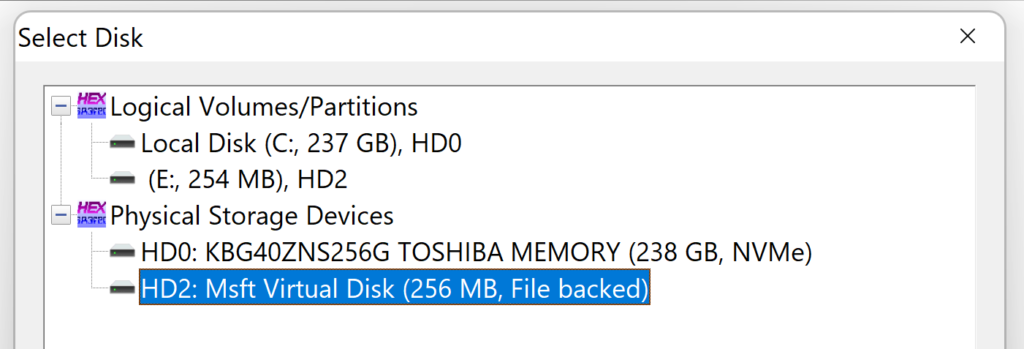
2.可以看到这个U盘上有“Start Sectors” 、“Partition 1(e:)”和“Partition gap”三块内容。对于OS来说 Partition 1 就是展现给用户的 e盘。

3.具体分析
3.1 Start Sectors 对应着LBA 0-33,使用WinHex 自带模板分析

分析结果如下:
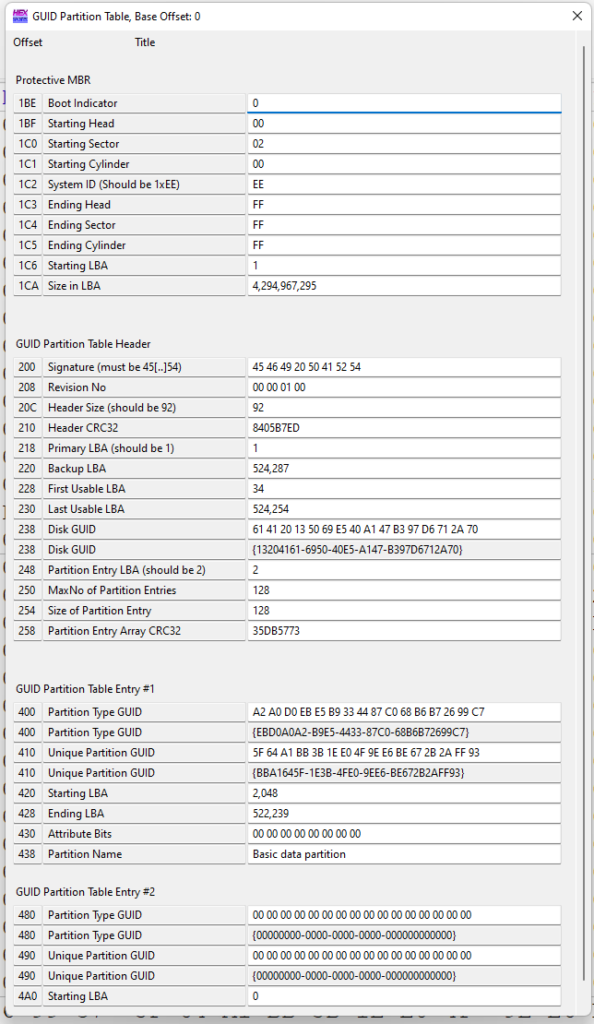
这是一个保护性的“假MBR”,作用是防止不识别GPT分区的格式意外破坏分区。0x0-0x1FF偏移(在LBA0中):提供了一个 Partition 的数组, EDK2示例代码会检查这里确定是“假MBR”;0x200-0x258 偏移(在LBA1中):给出第一个分区信息表的入口(Partition Entry LBA),一般为2,意思是这个信息表入口在 LBA 2 上;0x400-0x4A0偏移(在 LBA2中):给出第一个分区的入口(Starting LBA),这里可以看到第一个分区从 LBA 2048(D)开始
3.2 选中第一个分区,可以看到它位于 0x100000处(也就是 LBA 2048 处)。同样的继续使用内置模板进行查看获得基本信息

从上面我们可以看到,从这个位置开始 Reserved 了6190(D)个扇区,因此可以知道第一个FAT在LBA:2048+6190=8238(D)。查看 LBA 8238 (D)这个位置 ,看到的就是 FAT 表。下图框出来的就是每一个文件项。第一个簇标记为 0xFFFFFFF8,第二个簇为0xFFFFFFFFF(0号FAT项为肮脏标志;1号FAT项是一个结束标志,通常簇号是从2开始就是这个原因)。其余的0xFFFFFF0F表示这个簇对应的是目录或者文件的结尾。之前我们的讨论都是以扇区为单位的,等到了研究文件时,通常需要以簇为单位,二者之间的换算关系是 Sector Per cluster 参数给出的。例如,这个值为4,就表示1个Cluster 由4个Sector 组成。
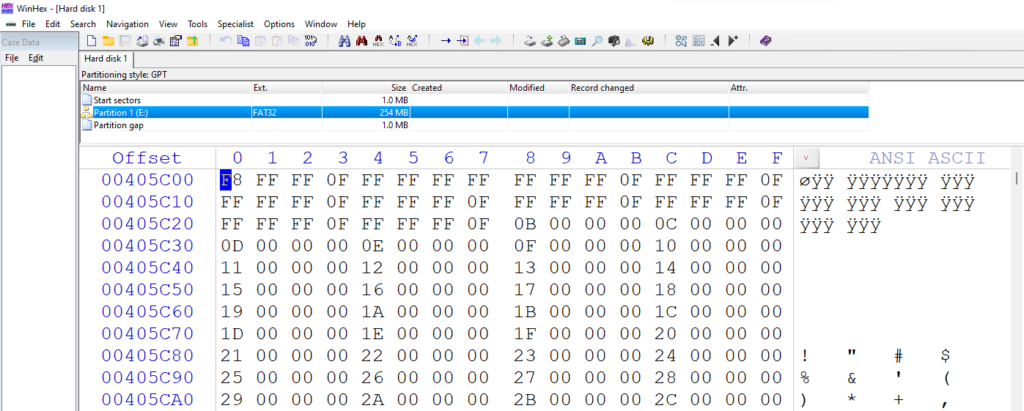
3.3 上面的概念不太容易理解,直接跳到数据区来进行查看。数据区的开始在:2048+6190+1001+1001=10240 扇区的位置:
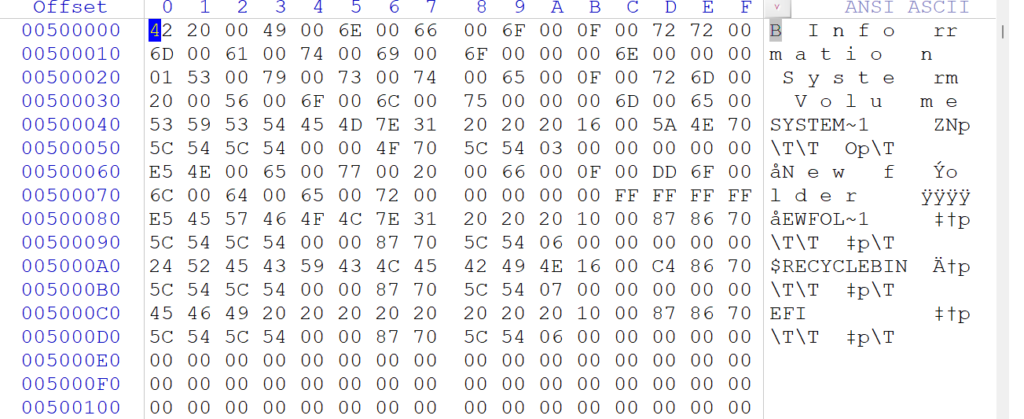
可以隐约看到右侧ASCII字符就是我们FAT32分区上的根目录(下图是切换到D: 的示意图,注意物理硬盘和分区上的扇区不同,本文都是以物理硬盘的扇区号为准):

我们知道 EFI 目录下有 BOOT 目录,其中有 BOOTX64.EFI 这个文件。我们下面的目标就是获得这个文件的内容。首先,移动光标到前面的 EFI 目录字样处
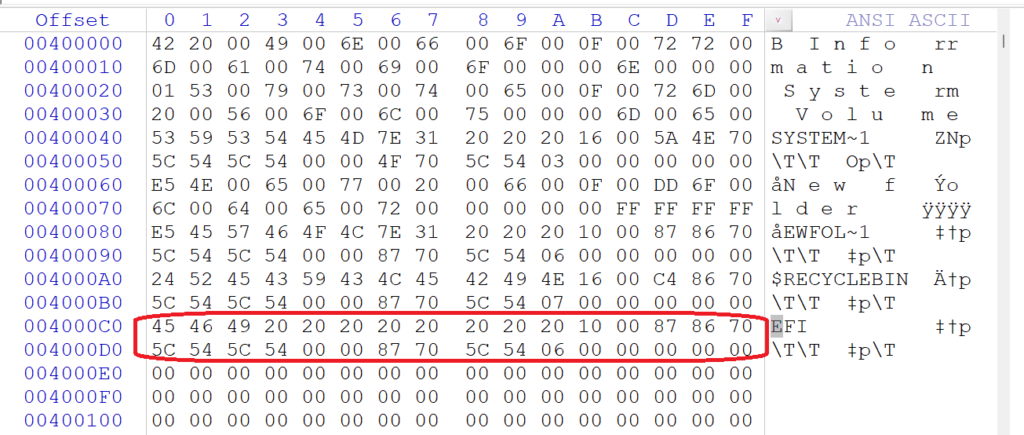
从菜单上选择模板 :
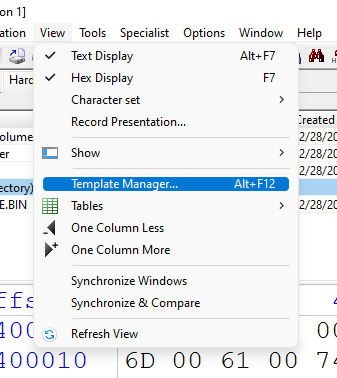
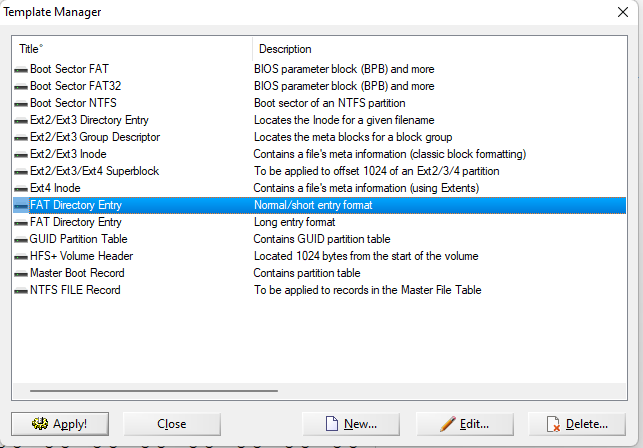
查看目录信息 如下:
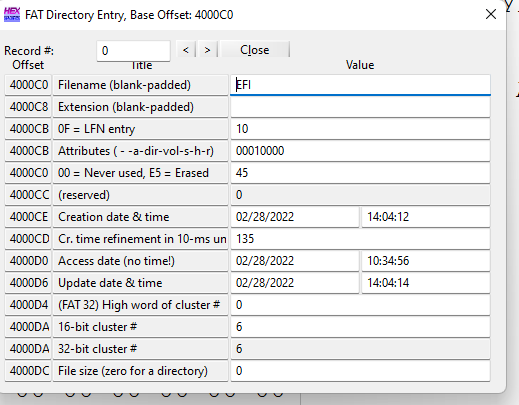
目录EFI 的数据在数据区起始扇区号+(簇号-2)*(扇区数/簇)
6号簇的绝对LBA就是 10240+(6-2)*4==10256扇区
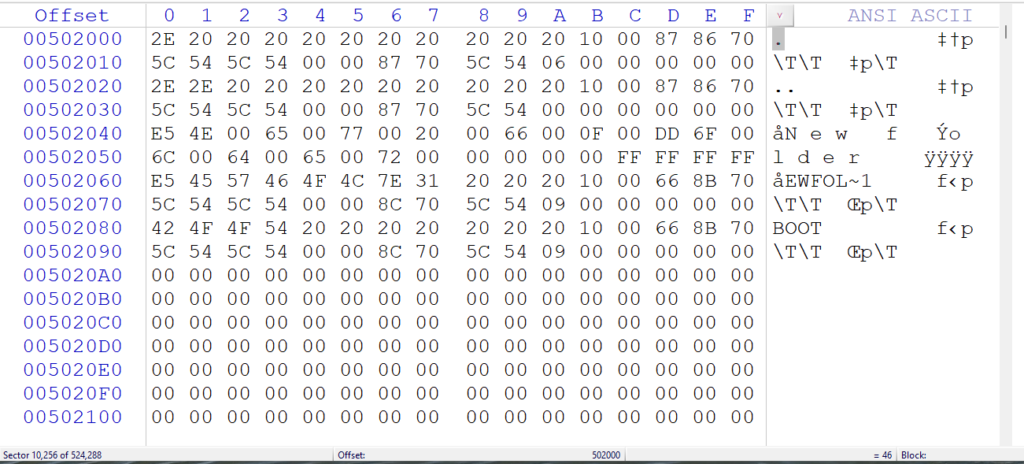
上面可以看到 BOOT 这个目录,再使用模板解析BOOT目录的数据
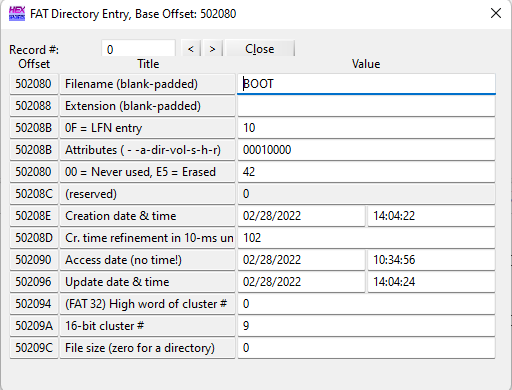
可以看到 BOOT 目录的数据位于9号簇,对应的绝对扇区是10240+(9-2)*4==10268
再查看这个扇区

这里就能看到 BOOTX64.EFI 文件了,再用模板解析 BOOTX64.EFI 的数据:
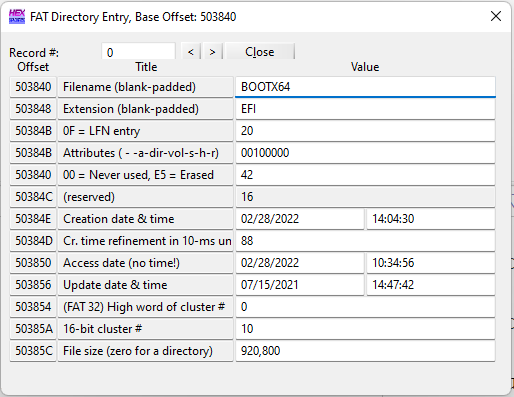
最终查看10240+(10-2)*4==10272扇区,就是 BOOTX64.EFI 的内容

从 10272到10275 是10号簇,接下来需要到 FAT中查看,可以看到下面的位置指向了11号簇,就是说BOOTX64.EFI 文件并未完结,接下来的内容可以在11号簇所在扇区
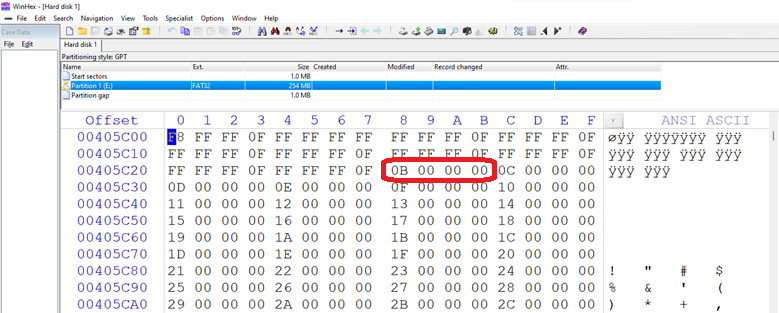
参考:
默认情况下, Console 程序的图标是下面这种。这次介绍一下如何用其他的图标来替换之。
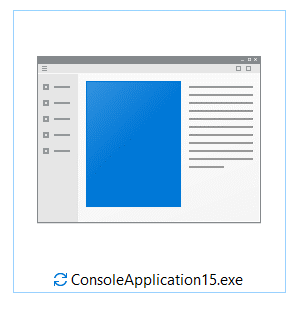
1.创建一个 Win32 Console 程序。在 Resource Files上点右键:
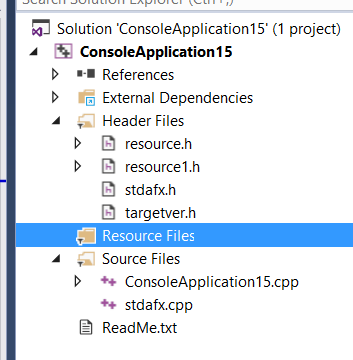
2.在弹出的菜单上选择 AddàResource…, 这样就为项目创建了一个 Resource文件
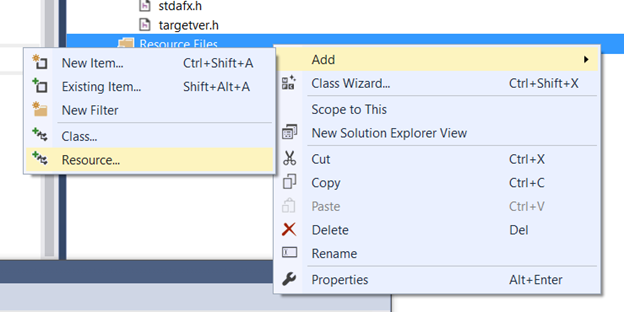
3.双击生成的 rc文件

4.跳转之后在文件上使用右键,选择 “Add Resources….”
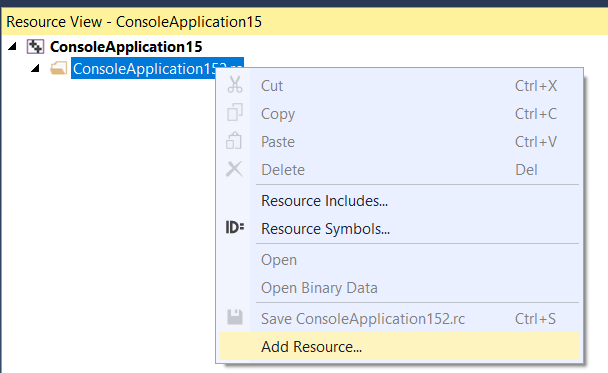
5.选择 Icon,然后 Import
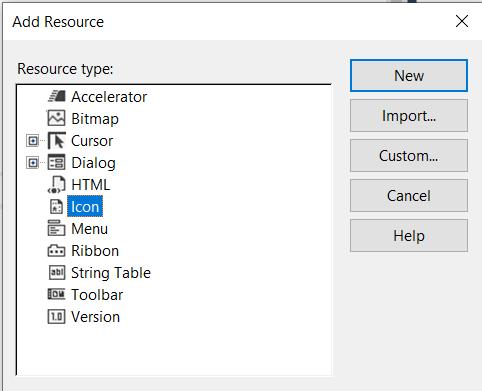
6.弹出的对话框上选择你需要的 icon文件

7.导入之后,在导入的图标上单击右键,选择 Properties….
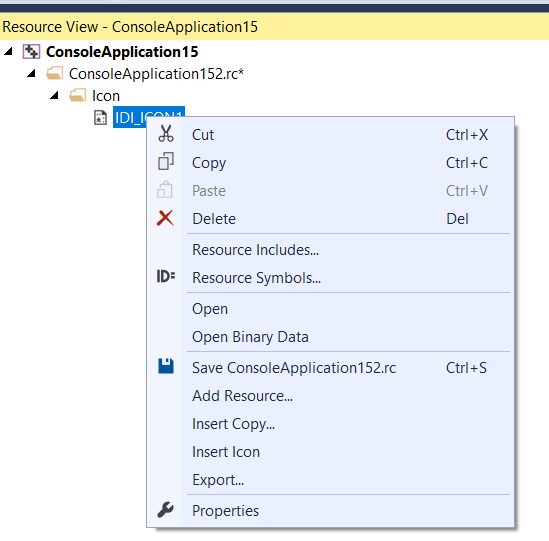
8.改ID为IDC_MAINFRAME
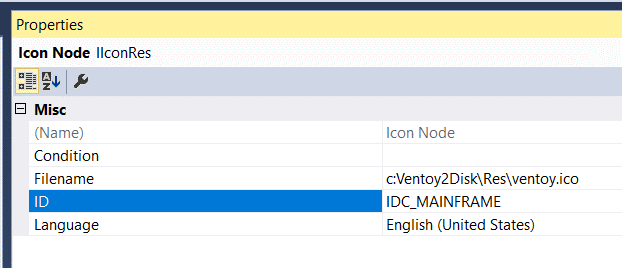
生成的EXE 如下:
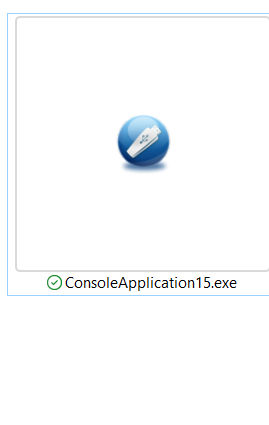
参考:
1. https://blog.csdn.net/weixin_30603633/article/details/96342177
UEFI Spec 介绍了一个 EFI_ACPI_TABLE_PROTOCOL,定义如下:

从介绍可以看出,我们能够使用这个 PROTOCOL 添加(Install)或者删除(Uninstall)一个 ACPI Table。
首先准备一个 ACPI Table, 这里顶一个一个叫做 LBZT 的 Table。
DefinitionBlock ("LABZT.AML", "LBZT", 2, "", "", 0x0)
{
Name(BUF1, Buffer(){0x00,0x01,0x02,0x03,0x04,0x05})
Name(BUF2, "www.lab-z.com")
}
DefinitionBlock语法定义如下【参考1】:
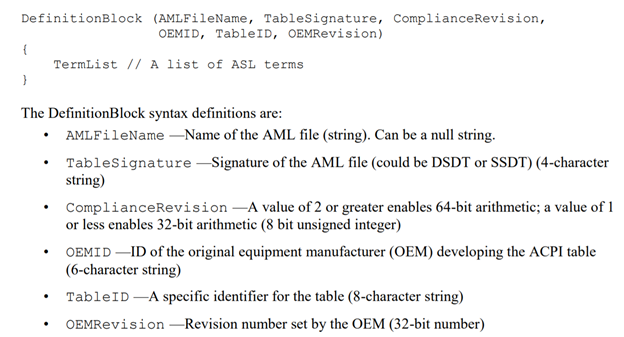
AMLFileName 是给编译器看的,用于指定输出的 AML 文件名;
TableSignature 是 ACPI Table 的名字(4字节)
ComplianceRevision, 2以及大于2是指定64位;1或者0指定32位(这里我不清楚具体差别,做了一个实验,比如定义:Name(BUF3, 0x1122334455),当ComplianceRevision为0时,编译之后结果发生截断,实际定义是Name(BUF3, 0x22334455);但是当ComplianceRevision为2时,编译结果和代码相同)。如果在处理较大的数值时,需要特别注意这里。
OEMID OEM自定义 ID
TableID OEM自定义Table 名称(8Bytes)
OEMRevision OEM自定义数值
接下来我们首先自定义一个 ACPI Table 如下:
DefinitionBlock ("LABZ64.AML", "LABZ", 2, "", "", 0x0)
{
Name(BUF1, Buffer(){0x00,0x01,0x02,0x03,0x04,0x05})
Name(BUF2, "www.lab-z.com")
Name(BUF3, 0x1122334455)
}
编译之:

得到的是一个二进制文件LABZ64.aml

使用工具转化为C的定义,我们就可以在代码中直接使用了。测试代码如下:
#include <Uefi.h>
#include <Library/UefiLib.h>
#include <Library/ShellCEntryLib.h>
#include <Library/UefiBootServicesTableLib.h>
#include <Protocol/AcpiTable.h>
extern EFI_BOOT_SERVICES *gBS;
EFI_GUID gEfiAcpiTableProtocolGuid ={
0xFFE06BDD, 0x6107, 0x46A6,
{ 0x7B, 0xB2, 0x5A, 0x9C, 0x7E, 0xC5, 0x27, 0x5C }};
/* Contents of file LABZ64.aml */
const long int LABZ64_aml_size = 85;
const unsigned char LABZ64_aml[85] = {
0x4C, 0x41, 0x42, 0x5A, 0x55, 0x00, 0x00, 0x00, 0x02, 0x7A, 0x00, 0x00, 0x00, 0x00, 0x00, 0x00,
0x00, 0x00, 0x00, 0x00, 0x00, 0x00, 0x00, 0x00, 0x00, 0x00, 0x00, 0x00, 0x49, 0x4E, 0x54, 0x4C,
0x18, 0x10, 0x19, 0x20, 0x08, 0x42, 0x55, 0x46, 0x31, 0x11, 0x09, 0x0A, 0x06, 0x00, 0x01, 0x02,
0x03, 0x04, 0x05, 0x08, 0x42, 0x55, 0x46, 0x32, 0x0D, 0x77, 0x77, 0x77, 0x2E, 0x6C, 0x61, 0x62,
0x2D, 0x7A, 0x2E, 0x63, 0x6F, 0x6D, 0x00, 0x08, 0x42, 0x55, 0x46, 0x33, 0x0E, 0x55, 0x44, 0x33,
0x22, 0x11, 0x00, 0x00, 0x00
};
int
EFIAPI
main (
IN int Argc,
IN char **Argv
)
{
EFI_STATUS Status;
EFI_ACPI_TABLE_PROTOCOL *AcpiTableProtocol;
UINTN TableKey;
Status = gBS->LocateProtocol(
&gEfiAcpiTableProtocolGuid,
NULL,
(VOID **)&AcpiTableProtocol);
if (EFI_ERROR(Status)) {
Print(L"Cannot find ACPI_TABLE_PROTOCOL \r\n");
return Status;
}
AcpiTableProtocol->InstallAcpiTable(
AcpiTableProtocol,
(VOID *)LABZ64_aml,
LABZ64_aml_size,
&TableKey);
gBS->CloseProtocol (
AcpiTableProtocol,
&gEfiAcpiTableProtocolGuid,
gImageHandle,
NULL );
return EFI_SUCCESS;
}
实体机上进行测试,运行 att.efi 之后可以使用 Acpiview 命令查看到如下:
--------------- LABZ Table ---------------
Address : 0x44B1D000
Length : 85
00000000 : 4C 41 42 5A 55 00 00 00 - 02 7A 00 00 00 00 00 00 LABZU....z......
00000010 : 00 00 00 00 00 00 00 00 - 00 00 00 00 49 4E 54 4C ............INTL
00000020 : 18 10 19 20 08 42 55 46 - 31 11 09 0A 06 00 01 02 ... .BUF1.......
00000030 : 03 04 05 08 42 55 46 32 - 0D 77 77 77 2E 6C 61 62 ....BUF2.www.lab
00000040 : 2D 7A 2E 63 6F 6D 00 08 - 42 55 46 33 0E 55 44 33 -z.com..BUF3.UD3
00000050 : 22 11 00 00 00 "....
Table Checksum : OK
ACPI Table Header :
Signature : LABZ
Length : 85
Revision : 2
Checksum : 0x7A
Oem ID :
Oem Table ID :
Oem Revision : 0x0
Creator ID : INTL
Creator Revision : 0x20191018
Table Statistics:
0 Error(s)
0 Warning(s)
再进一步,启动到 Windows后用 RW 进行查看也可以看到 LABZ Table
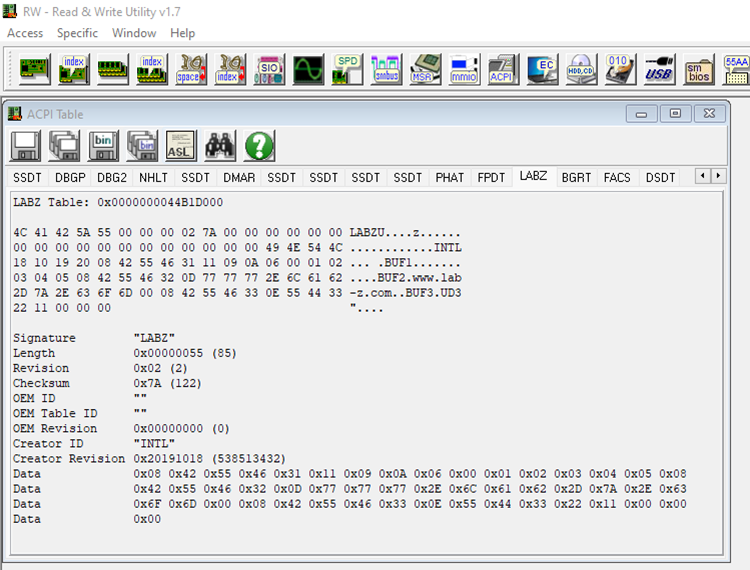
完整代码下载:
参考:
1. https://acpica.org/sites/acpica/files/asl_tutorial_v20190625.pdf
介绍一个简单的倒计时关闭 Console 程序的方法,下面在 VS2015 下编译通过:
#include "stdafx.h"
#include <conio.h>
#include <windows.h>
int main()
{
int j = 0;
while ((!_kbhit())&&j<50) {
printf("\n no key pressed. %d", j);
Sleep(1000);
j++;
}
_getch();
return 0;
}
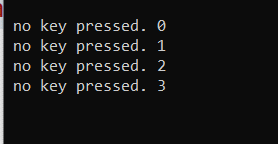
书接上回,下面的语句输出了第一条 Debug Log,它位于 SecMain.c 中:
DEBUG ((DEBUG_INFO,
"SecCoreStartupWithStack(0x%x, 0x%x)\n",
(UINT32)(UINTN)BootFv,
(UINT32)(UINTN)TopOfCurrentStack
));
接下来就使用下面的语句跳转到SecStartupPhase2中:
//
// Initialize Debug Agent to support source level debug in SEC/PEI phases before memory ready.
//
InitializeDebugAgent (DEBUG_AGENT_INIT_PREMEM_SEC, &amp;SecCoreData, SecStartupPhase2);
这个函数位于 \MdeModulePkg\Library\DebugAgentLibNull\DebugAgentLibNull.c,从代码上看到就是一个跳转而已:
/**
Initialize debug agent.
This function is used to set up debug environment to support source level debugging.
If certain Debug Agent Library instance has to save some private data in the stack,
this function must work on the mode that doesn't return to the caller, then
the caller needs to wrap up all rest of logic after InitializeDebugAgent() into one
function and pass it into InitializeDebugAgent(). InitializeDebugAgent() is
responsible to invoke the passing-in function at the end of InitializeDebugAgent().
If the parameter Function is not NULL, Debug Agent Library instance will invoke it by
passing in the Context to be its parameter.
If Function() is NULL, Debug Agent Library instance will return after setup debug
environment.
@param[in] InitFlag Init flag is used to decide the initialize process.
@param[in] Context Context needed according to InitFlag; it was optional.
@param[in] Function Continue function called by debug agent library; it was
optional.
**/
VOID
EFIAPI
InitializeDebugAgent (
IN UINT32 InitFlag,
IN VOID *Context, OPTIONAL
IN DEBUG_AGENT_CONTINUE Function OPTIONAL
)
{
if (Function != NULL) {
Function (Context);
}
}
继续在 SecMain.c中执行SecStartupPhase2() 函数,这个函数负责找到 PEI Core 的 Entry Point
/**
Caller provided function to be invoked at the end of InitializeDebugAgent().
Entry point to the C language phase of SEC. After the SEC assembly
code has initialized some temporary memory and set up the stack,
the control is transferred to this function.
@param[in] Context The first input parameter of InitializeDebugAgent().
**/
VOID
EFIAPI
SecStartupPhase2(
IN VOID *Context
)
其中的跳转代码如下:
//
// Transfer the control to the PEI core
//
(*PeiCoreEntryPoint) (SecCoreData, (EFI_PEI_PPI_DESCRIPTOR *)&mPrivateDispatchTable);
其中 PeiCoreEntryPoint 类型是 EFI_PEI_CORE_ENTRY_POINT ,定义可以在 \mdepkg\include\pi\PiPeiCis.h 看到:
/**
The entry point of PEI Foundation.
This function is the entry point for the PEI Foundation, which
allows the SEC phase to pass information about the stack,
temporary RAM and the Boot Firmware Volume. In addition, it also
allows the SEC phase to pass services and data forward for use
during the PEI phase in the form of one or more PPIs. These PPI's
will be installed and/or immediately signaled if they are
notification type. There is no limit to the number of additional
PPIs that can be passed from SEC into the PEI Foundation. As part
of its initialization phase, the PEI Foundation will add these
SEC-hosted PPIs to its PPI database such that both the PEI
Foundation and any modules can leverage the associated service
calls and/or code in these early PPIs.
@param SecCoreData Points to a data structure containing
information about the PEI core's
operating environment, such as the size
and location of temporary RAM, the stack
location and the BFV location.
@param PpiList Points to a list of one or more PPI
descriptors to be installed initially by
the PEI core. An empty PPI list consists
of a single descriptor with the end-tag
EFI_PEI_PPI_DESCRIPTOR_TERMINATE_LIST.
As part of its initialization phase, the
PEI Foundation will add these SEC-hosted
PPIs to its PPI database such that both
the PEI Foundation and any modules can
leverage the associated service calls
and/or code in these early PPIs.
**/
typedef
VOID
(EFIAPI *EFI_PEI_CORE_ENTRY_POINT)(
IN CONST EFI_SEC_PEI_HAND_OFF *SecCoreData,
IN CONST EFI_PEI_PPI_DESCRIPTOR *PpiList
);
接下来的跳转进入\MdePkg\Library\PeiCoreEntryPoint\PeiCoreEntryPoint.c 中的ModuleEntryPoint()
/**
The entry point of PE/COFF Image for the PEI Core.
This function is the entry point for the PEI Foundation, which allows the SEC phase
to pass information about the stack, temporary RAM and the Boot Firmware Volume.
In addition, it also allows the SEC phase to pass services and data forward for use
during the PEI phase in the form of one or more PPIs.
There is no limit to the number of additional PPIs that can be passed from SEC into
the PEI Foundation. As part of its initialization phase, the PEI Foundation will add
these SEC-hosted PPIs to its PPI database such that both the PEI Foundation and any
modules can leverage the associated service calls and/or code in these early PPIs.
This function is required to call ProcessModuleEntryPointList() with the Context
parameter set to NULL. ProcessModuleEntryPoint() is never expected to return.
The PEI Core is responsible for calling ProcessLibraryConstructorList() as soon as
the PEI Services Table and the file handle for the PEI Core itself have been established.
If ProcessModuleEntryPointList() returns, then ASSERT() and halt the system.
@param SecCoreData Points to a data structure containing information about the
PEI core's operating environment, such as the size and
location of temporary RAM, the stack location and the BFV
location.
@param PpiList Points to a list of one or more PPI descriptors to be
installed initially by the PEI core. An empty PPI list
consists of a single descriptor with the end-tag
EFI_PEI_PPI_DESCRIPTOR_TERMINATE_LIST.
As part of its initialization phase, the PEI Foundation will
add these SEC-hosted PPIs to its PPI database, such that both
the PEI Foundation and any modules can leverage the associated
service calls and/or code in these early PPIs.
**/
VOID
EFIAPI
_ModuleEntryPoint(
IN CONST EFI_SEC_PEI_HAND_OFF *SecCoreData,
IN CONST EFI_PEI_PPI_DESCRIPTOR *PpiList
)
{
ProcessModuleEntryPointList (SecCoreData, PpiList, NULL);
//
// Should never return
//
ASSERT(FALSE);
CpuDeadLoop ();
}
函数中会调用一个构造函数:
\Build\OvmfX64\NOOPT_VS2015x86\X64\MdeModulePkg\Core\Pei\PeiMain\DEBUG\AutoGen.c
VOID
EFIAPI
ProcessModuleEntryPointList (
IN CONST EFI_SEC_PEI_HAND_OFF *SecCoreData,
IN CONST EFI_PEI_PPI_DESCRIPTOR *PpiList,
IN VOID *Context
)
{
PeiCore (SecCoreData, PpiList, Context);
}
最终,跳入位于\MdeModulePkg\Core\Pei\PeiMain\PeiMain.c中的如下函数:
/**
This routine is invoked by main entry of PeiMain module during transition
from SEC to PEI. After switching stack in the PEI core, it will restart
with the old core data.
@param SecCoreDataPtr Points to a data structure containing information about the PEI core's operating
environment, such as the size and location of temporary RAM, the stack location and
the BFV location.
@param PpiList Points to a list of one or more PPI descriptors to be installed initially by the PEI core.
An empty PPI list consists of a single descriptor with the end-tag
EFI_PEI_PPI_DESCRIPTOR_TERMINATE_LIST. As part of its initialization
phase, the PEI Foundation will add these SEC-hosted PPIs to its PPI database such
that both the PEI Foundation and any modules can leverage the associated service
calls and/or code in these early PPIs
@param Data Pointer to old core data that is used to initialize the
core's data areas.
If NULL, it is first PeiCore entering.
**/
VOID
EFIAPI
PeiCore (
IN CONST EFI_SEC_PEI_HAND_OFF *SecCoreDataPtr,
IN CONST EFI_PEI_PPI_DESCRIPTOR *PpiList,
IN VOID *Data
)
前面可以看到,这里是通过 ProcessModuleEntryPointList (SecCoreData, PpiList, NULL); 进行调用的,因此,这里Data==NULL,所以也是第一次运行:
//
// Retrieve context passed into PEI Core
//
OldCoreData = (PEI_CORE_INSTANCE *) Data;
SecCoreData = (EFI_SEC_PEI_HAND_OFF *) SecCoreDataPtr;
//
// Perform PEI Core phase specific actions.
//
if (OldCoreData == NULL) {
//
// If OldCoreData is NULL, means current is the first entry into the PEI Core before memory is available.
//
ZeroMem (&PrivateData, sizeof (PEI_CORE_INSTANCE));
PrivateData.Signature = PEI_CORE_HANDLE_SIGNATURE;
CopyMem (&PrivateData.ServiceTableShadow, &gPs, sizeof (gPs));
}
其中PrivateData 是 PEI_CORE_INSTANCE PrivateData; 其中 PEI_CORE_INSTANCE 定义在PeiMain.h 中报错了 Pei Core 的一些信息,比如:当前 Fv中的 FFS 个数等等。第一次进入PeiCore 的时候(OldCoreData == NULL),代码会准备PrivateData的内容。